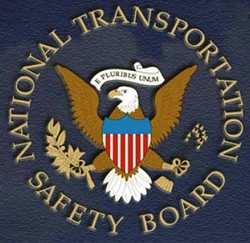Thu, Sep 17, 2009
ATC Is Again Becoming A Focus Of The Investigation
 NTSB Chair Debora Hersman told the
U.S. House Committee on Transportation and Infrastructure Aviation
Subcommittee that the pilot of a Piper PA-32 which collided with a
sightseeing helicopter over the Hudson River incorrectly read back
a radio frequency, and was not corrected by air traffic controllers
at Teterboro (TEB).
NTSB Chair Debora Hersman told the
U.S. House Committee on Transportation and Infrastructure Aviation
Subcommittee that the pilot of a Piper PA-32 which collided with a
sightseeing helicopter over the Hudson River incorrectly read back
a radio frequency, and was not corrected by air traffic controllers
at Teterboro (TEB).
Hersman's statement came during her prepared remarks to the
subcommittee Wednesday. "The pilot read back to the controller an
incorrect frequency; ATC recordings do not indicate that the
incorrect read-back was heard or corrected by any air traffic
controller," Hersman said in her statement. "A preliminary review
of recorded ATC communications showed that the pilot did not
contact EWR (Newark Liberty International Airport) before the
accident. We are reviewing ATC tapes for other frequencies to see
if the pilot was attempting to contact EWR on the incorrect
frequency. In any case, about 11:53:17, approximately the time of
the accident, the TEB local controller contacted the EWR controller
to ask about the airplane and was told that the pilot had not
called. There are no known additional ATC contacts with the
airplane."
But Hersman also indicated that the Hudson corridor is very busy
airspace, and while there have been a number of near-collisions in
the region, pilots generally transit the area safely. "Recent FAA
traffic estimates indicate that over 200 aircraft a day pass
through the Hudson River class B exclusion area," she said. "The
Hudson River class B exclusion area and associated transition
procedures have been in use for more than 30 years, and until the
accident, the safety record for operations in the area had been
good. The NTSB has no record of previous collisions between
aircraft operating in the Hudson River class B exclusion area."

NTSB Chair Hersman
"A review of the FAA Near-Midair Collision (NMAC) database and
the National Aeronautics and Space Administration Aviation Safety
Reporting System (ASRS) database revealed 11 reports of NMACs
between aircraft in the area since 1990," she continued. "Only one
report was filed in the past 10 years. Although ASRS reporting is
voluntary, the number of reports received is very low relative to
the number of flight operations through the Hudson River class B
exclusion area."
Hersman reiterated NTSB's proposed changes to the class B
airspace in the Hudson River corridor. "On September 2, 2009, the
FAA announced plans to modify the airspace over the Hudson River,"
she said. "The NTSB will review the changes, once they are
completed and published, and determine if they meet the intent of
our recommendations."
More News
Aero Linx: Aviators Code Initiative (ACI) Innovative tools advancing aviation safety and offering a vision of excellence for aviators. The ACI materials are for use by aviation pra>[...]
Make Sure You NEVER Miss A New Story From Aero-News Network Do you ever feel like you never see posts from a certain person or page on Facebook or Instagram? Here’s how you c>[...]
From 2016 (YouTube Edition): Who You Gonna Call When You Have a Rocket Engine that Needs a Spacecraft? While at EAA AirVenture 2016, ANN CEO and Editor-In-Chief, Jim Campbell, sat >[...]
"In my opinion, if this isn't an excessive fine, I don't know what is... The odds are good that we're gonna be seeking review in the United States Supreme Court. So we gotta muster>[...]
Expedite Used by ATC when prompt compliance is required to avoid the development of an imminent situation. Expedite climb/descent normally indicates to a pilot that the approximate>[...]
 ANN's Daily Aero-Linx (04.30.25)
ANN's Daily Aero-Linx (04.30.25) ANN FAQ: Turn On Post Notifications
ANN FAQ: Turn On Post Notifications Classic Aero-TV: Agile Aeros Jeff Greason--Disruptive Aerospace Innovations
Classic Aero-TV: Agile Aeros Jeff Greason--Disruptive Aerospace Innovations Aero-News: Quote of the Day (04.30.25)
Aero-News: Quote of the Day (04.30.25) ANN's Daily Aero-Term (04.30.25): Expedite
ANN's Daily Aero-Term (04.30.25): Expedite




